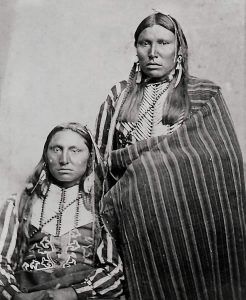

True hunters, the Comanche primarily subsisted off of the millions of buffalo that existed surrounding the spring. The powerful Apache tribe was forced from their original homelands by the Comanche, and ended up settling in New Mexico, Arizona, and far West Texas. The Kiowas formed a strategic alliance with the Comanche, often warring and hunting with them. The Tonkawa tribe was nearly eradicated by the Comanche, and the remnants of that tribe often became the scouts of the United States Army, helping to track down their arch-enemies. In fact, many tribes completely abandoned the Southern Great Plains rather than continuously fight with the powerful Comanche. So adept were the Comanche with their horses in the art of war, that no other tribe on the plains dared to move into their territory.

Warriors measured their wealth by the number of horses in their herd, with some of the more powerful war chiefs having well in excess of 100 ponies in their possession.

From the spring site, the Comanche ruled for 200 years without rivals.ĭescribed by visiting European generals as "The Finest Light Cavalry in the World", the Comanche developed an uncanny relationship with the horse. The big spring was documented as one of the most important sites for the entire Comanche Nation, where generations met to form the Great Comanche War Trail which branched off to the south and west for their raids into Mexico, north to the edge of the caprock and the safety of the Llano Estacado, northeast to fertile hunting grounds in present day Oklahoma, and east for raids on the settlements of central Texas. The western heart of Comancheria was the spring. No other force halted the expansion of America into the American West, and yet the Comanche not only halted expansion for 40 years, but actually pushed-back settlements as panicked emigrants and settlers left the Texas prairies in scores, abandoning their farms and ranches because of Comanche raids, often conducted at night under the famed "Comanche Moon". Mexico, tired of having their settlers driven from their northern territory of Texas, instead encouraged Americans and other Europeans to settle their frontier for them, setting up the inevitable drive for Texas independence by those same settlers. The Spaniards realized that they could not defeat the Comanche in battle, and instead tried with some limited success to develop trade routes across the region, opting for peace instead of war. The Comanche kept the French from moving north from their territories in Mexico and the Gulf Coast. It's existence and importance to the regions of Texas cannot be overstated. The great Comanche Nation, sometimes referred to as Comancheria, covered a huge region, larger than all of New England.

This tribe of hunter-gatherers soon discovered the horse, and one of the great symbiotic relationships between humans and animals was formed and forever changed the history of what would become Texas. About the same time, a group of Native Americans speaking a Shoshone dialect moved out of the lands of present day Wyoming and Idaho and onto the plains. During the panic to leave, the Spaniards left behind or released thousands of their horses onto the Southern Great Plains. During the Pueblo Revolt of 1680, the indigenous Pueblo tribe of the Santa Fe area killed over 400 Spanish colonials, driving the remainder of them out of Northern New Mexico.


 0 kommentar(er)
0 kommentar(er)
